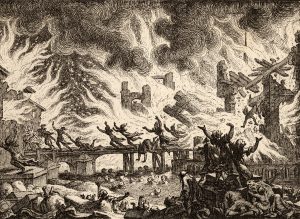 Explosion kills 200.
Explosion kills 200.
1780, Stalemated in New York and New Jersey, British turn to a Southern strategy, sending 12,000 men and a substantial fleet to take Charles Town after a six-week siege, May 12. (They have held Savannah since Dec. 29, 1778.)
The British count 5,266 prisoners, the largest American surrender of the war; many later escape, others suffer on prison ships in Charles Town Harbor. An accidental magazine explosion in the city kills 200 from both sides.
British Gen. Clinton’s great success is undermined, however, by lack of a Loyalist upswelling in the Carolinas. Americans put together hit-and-run militia opposition led by Francis Marion, Andrew Pickens and Thomas Sumter. Gen. Nathanael Greene arrives with Continental troops, December.
1780, Pennsylvania Assembly adopts a policy of gradual abolition, March 1, freeing children of all slaves born after Nov. 1, although they are to continue as indentured servants until their 28th birthday.
It is the first significant emancipation law anywhere in the New World.
Supporters, led by Quaker Anthony Benezet, note hypocrisy of Americans "who condemned the tyranny of England's colonial policies…while holding one-fifth of the colonial population in chains."
Legislation passes by a 34-21 vote, 108 years after the Germantown Quakers issued their first protest against enslavement.
1780, Black people number 10,000 in British-held New York City. Many are escaped slaves responding to British promise of freedom to all who leave rebel masters; they include two of Washington’s slaves. At war’s end, 3,000 blacks join Loyalists abandoning New York for Nova Scotia.
1780, Escaped slaves, led by Jean Saint Malo, set up a maroon community in swamps downriver from New Orleans (now under Spanish rule). Militia captures 60 of them in 1783; Saint Malo is charged with murder and hanged.
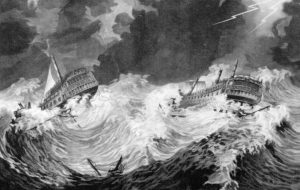 Royal Navy victimized.
Royal Navy victimized.
1780, Great Hurricane of 1780 sweeps through Lesser Antilles and over Puerto Rico, killing an estimated 22,000, the deadliest Atlantic hurricane on record.
It is the second of three October hurricanes which together sink or disable 15 Royal Navy warships, drowning most of their crews.
Opposing French lose several troop transports and many soldiers, but only one frigate.
1780, Britain declares war on the Netherlands, Dec. 20, provoked by the central role the Dutch free-port of Sint Eustasius is playing in supplying the American rebels.
1780, The London Society of West India Planters and Merchants is formed to resist the growing movement to abolish the slave trade. It includes a number of parliament members who are absentee plantation owners, slave-ship owners, sugar merchants or colonial agents.
London merchant Beeston Long and his family are leaders well into the 19th century.
 Túpac Amaru II.
Túpac Amaru II.
1780, Major Indian uprisings on the high-Andes plateau of Peru are led by Túpac Amaru II, a Quechua cacique, and Túpac Katari, an Aymara trader (who take their noms de guerre from earlier Inca leaders). They oppose forced work in Potosí mines and Bourbon Reform taxes levied to defend New Spain against the British.
Followers of each man swarm to 40,000-plus. Each is also joined in the fighting by his wife and other female leaders.
Túpac Amaru II and wife Micaela Bastidas attack Cuzco, to the north, in March, but are turned back with heavy loss. Spanish viceroy’s mostly Indian loyalist army surrounds rebels and captures Amaru II. His wife and son are executed before he is quartered, May 18.
Meanwhile, Túpac Katari besieges La Paz (capital of present-day Bolivia), south of Lake Titicaca. Siege continues for 109 days, led by his partner, Bartolina Sisa, before Spanish forces and Indian allies break through, Oct. 17. Katari and Sisa are betrayed and captured. She is hanged, he is drawn and quartered, November.
Followers, including many women, continue guerrilla war through May 1782, when viceroys of Peru and Rio de la Plata offer general pardon.
Deaths of as many as 100,000 Quechua and Aymara, and another 10,000-plus mestizos and criollos testify to brutality of conflict on both sides. Vestiges of Inca culture and office of cacique are suppressed afterward. Seen as a prelude to successful revolutions of early 19th century.
1781, New York State offers to pay masters to assign slaves to militia, with a further promise that they will be freed at war’s end. A quarter of the militia in White Plains that joins Washington’s march to Yorktown is black.
1781, Large invasion force under Adm. George Rodney and Gen. Vaughn compels Dutch surrender at Sint Eustasius, February. British capture 130 merchant ships in harbor and much loot in the huge warehouses, with Rodney focusing anger on Jewish merchants in particular.
1781, Revolt of the Comuneros erupts in Socorro, New Granada (now Columbia), March. Popular uprising protests new taxes on tobacco and brandy (a Bourbon reform intended to pay for New Spain’s defenses against the British).
More than 10,000 rebels, led by Juan Francisco Berbero, a criollo, march toward Bogotá, defeat an opposing force and then negotiate acceptance of demands with archbishop.
Back in Bogotá, the archbishop nullifies the agreement as the viceroyalty awaits reinforcements and then forces new taxes on cities. Berbero survives, but other leaders are run down, and executed or imprisoned for life.
1781, A French fleet under Adm. François, Comte de Grasse, sails from Cap-François in Saint-Domingue to defeat a British fleet led by Adm. Thomas Graves sailing from New York in the Battle of the Capes, Sept. 5-9, leaving the French ships in command of Chesapeake Bay.
Note: This critical victory is credited in part to early dispatch of French ships north to avoid a replay of hurricane damage suffered in October 1780. British kept more of their ships (many still under repair from storms) in the Caribbean, including Rodney’s fleet at Sint Eustasius, where it was busy rounding up Dutch merchant prizes and loot.
1781, In separate cases, Massachusetts courts rule in favor of slaves Elizabeth Freeman and Quok Walker who sue for their freedom, citing the new (1780) state constitution’s declaration that “all men are born free and equal.”
This effectively ends slavery in Massachusetts, with some masters formally manumitting and others attempting to hold slaves as indentured servants. In 1790, first U.S. census reports no slaves remain in the state.
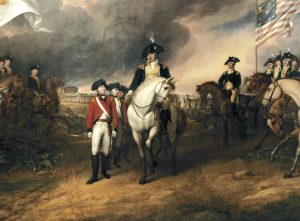 Cornwallis and Washington.
Cornwallis and Washington.
1781, Cornwallis, unable to escape Yorktown thanks to the defeat of Graves’ British fleet, surrenders his army to Washington and Rochambeau, Oct. 19, giving the Americans ultimate victory in the Revolution. Treaty of Paris follows in September 1783.
1781, In separate cases, Massachusetts courts rule in favor of slaves Elizabeth Freeman and Quok Walker who sue for their freedom, citing the new (1780) state constitution’s declaration that “all men are born free and equal.”
This effectively ends slavery in Massachusetts, with some masters formally manumitting and others attempting to hold slaves as indentured servants. In 1790, first U.S. census reports no slaves remain in the state.
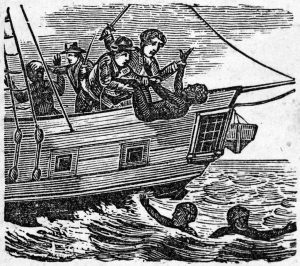 Slaves forced overboard.
Slaves forced overboard.
1781, Officers of Liverpool slaver Zong order more than 130 captives thrown overboard over several days after ship overshoots Jamaica, struggles to recover and runs low on water, beginning Nov. 29. Ship was way overloaded with 442 slaves when it departed Accra with stop at São Tomé; only 208 survive. In 1783 trials in London, owners argue they are due insurance on each lost slave. Lord Mansfield, chief justice, rules for insurers.
Incident becomes rallying story for British abolition movement, and subject of 1839 Turner painting “The Slave Ship.”
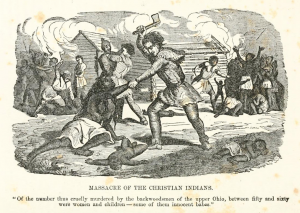 Christian Indians die.
Christian Indians die.
1782, Nearly 100 Christian Lenape, including 29 women and 39 children, executed by frontier militia at Gnadenhutten (present-day Ohio), in retaliation for various raids into Pennsylvania, of which these Lenape, part of a pacifist community, deny knowledge. Militia makes off with plunder.
1782, France’s main object in allying with Americans against Britain—to take sugar-rich Jamaica and smaller British-held Caribbean islands—is thwarted by Adm. De Grasse’s defeat in the huge Battle of the Saints, April 9-12, off Dominica.British fleet under Adm. Rodney captures four major French vessels, inflicts thousands of casualties and takes De Grasse prisoner.
Spain, ally of France and the Americans, also fails in its central objective—to take back Gibraltar—when a combined French-Spanish force of 60,000, 49 ships and 10 “floating batteries” is turned away with heavy loss in the largest single battle of the war, Sept. 13.
For Britain, these victories go a long way in taking the sting out of their defeat at Yorktown.
1782, British evacuate Charles Town, Dec. 14, taking 4,200 Loyalists and 5,000 people of African descent, most of them still in bondage to Loyalists. But hundreds who won freedom, by escaping American-rebel masters for British lines, will eventually settle in Canada, the Caribbean or Sierra Leone.
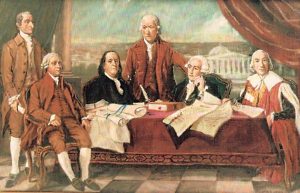 The negotiators.
The negotiators.
1783, Peace of Paris ends Revolutionary War, Sept. 3. Independent U.S. is granted vast territory to the Mississippi. Britain also cedes Florida back to Spain, while retaining Canada and Gibraltar, and regaining St. Vincent and the Bahamas.
Revolution deaths: On the North American battlefield, 6,800 on American side; French, 2,100; British, 6,000; Germans (in British service), 1,800; Loyalists, 1,700. At least 17,000 on American side die of disease, many of them on British prison ships anchored in East River off Brooklyn (these include many sailors seized on American privateers and merchant ships). 5,300 Loyalists die of disease.
Total Indian deaths are unknown. Perhaps 4,900 Germans also deserted to stay in America.
1783, Final evacuation of British troops and more than 25,000 Loyalists from New York, Nov. 25. These include many Black Loyalists, taken to Nova Scotia.
A number of Loyalists from other colonies win land grants in Bahamas; they develop cotton plantations, transfer their slaves and import more. Most of today’s Bahamians said to be descended from those slaves. Others are settled in Bahamas as freed blacks after their liberation from slave ships (post 1807).
1783, In London, 300 Quakers present the first petition submitted to Parliament to abolish the slave trade, June 16. Lord North, the prime minister, asserts that slave trade is economically essential for every major European nation.
1783, In Philadelphia, 534 Quakers from Pennsylvania, Delaware and New Jersey, and western Maryland and Virginia petition the Continental Congress “to discourage and prevent so obvious an Evil” as the slave trade, Oct. 4. Leaders include William Savery, Henry Drinker and Abel James.
Although successful with Pennsylvania Assembly in 1780, Quakers are less so with Congress.
One reason: Most Quakers refused to take up arms during Revolution (with Drinker and James among 20 Friends exiled in 1777 from Philadelphia to Virginia). Thus, they lose influence with Congress in immediate post-war years.
1783, Maryland joins Virginia in banning the import of slaves, but not slavery. This comes three years after Maryland raised tax on importing slaves to a prohibitive $500.
1783, Spain offers 32-acre lots on Trinidad to white Catholics willing to settle and 16 acres to free people of color, and more land for each slave they bring. This Cedula of Population is credited with attracting people from nearby French islands and boosting population in the so-far failed colony from 1,400 in 1777 to more than 15,000 1789.
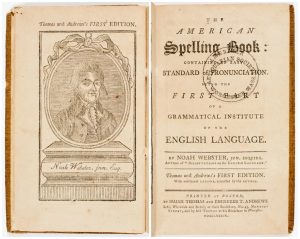 Noah Webster's Blue-Backed Speller.
Noah Webster's Blue-Backed Speller.
1784, Noah Webster, former teacher and vocal critic of America’s haphazard schooling of children, issues his “Blue-Backed Speller” (actually, the first part of his Grammatical Institute of the English Language). The Speller is arranged to be taught as children grow older and to rescue English language from “corruptions” of British aristocracy.
It quickly supersedes The New-England Primer to be leading book in teaching U.S. children to read, spell and pronounce words. It sells 15 million copies by 1837, when first McGuffy’s Readers come out.
1784, In wake of war, Britain’s Triangular Trade—British-made goods to trade for slaves in Africa; slaves to Caribbean and American colonies; slave-plantation sugar, tobacco and cotton to Britain—will soon account for roughly 80 percent of Britain’s foreign revenue. In these peak years, British ships carry 40,000 enslaved men, women and children across the Atlantic. At least 13% of total die on voyage.
1784, Rhode Island and Connecticut pass gradual emancipation laws. New Hampshire has virtually no slaves, but does not codify emancipation.
1784, James Ramsey publishes, in London, “An essay on the treatment and conversion of African slaves in the British sugar colonies,” which has major impact on coalescing British abolitionists.
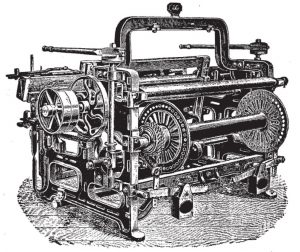 Edmund Cartwright's power loom.
Edmund Cartwright's power loom.
1785, First power loom introduced in England by Edmund Cartwright. Modified and improved over the following decades, 100,000 are operating by 1833. Manchester develops into the center of the cotton-textile industry, which leads the entire Industrial Revolution.
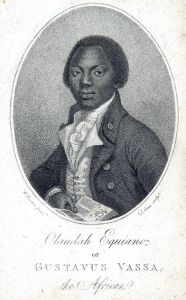 Olaudah Eaquino.
Olaudah Eaquino.
1786-1789, More anti-slavery narratives and reports appear, including Thomas Clarkson’s A Summary View of the Slave Trade and of the Probable Consequences of its Abolition, 1786; John Newton’s Thoughts upon the African Slave Trade, 1787; Olaudah Equiano’s The Interesting Narrative of the Life of Olaudah Equiano, 1789.
West Indies plantation owners counter with Thomas Bellamy’s play, The Benevolent Planters, 1789.
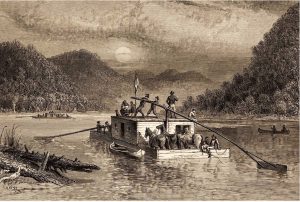 1787, Northwest Ordinance, based on an earlier bill written by Jefferson, excludes slavery from new U.S. territories ceded first by Britain and then by original states to federal government, north of Ohio River.
1787, Northwest Ordinance, based on an earlier bill written by Jefferson, excludes slavery from new U.S. territories ceded first by Britain and then by original states to federal government, north of Ohio River.
Includes present-day Ohio, Indiana, Michigan, Illinois, Wisconsin and Minnesota east of Mississippi. Confederation Congress approves, 17-1, with all five Southern delegations present voting in favor, July 13.
Why the Southern support? Original Jefferson bill would have banned slavery south of Ohio river as well (in territories that become Kentucky, Tennessee, Alabama and Mississippi), but those are not included in final bill. Also, without slaves, Northwest farmers cannot threaten competition against Southern tobacco and indigo plantations. Finally, the ordinance includes a fugitive-slave clause to apply to the no-slave territories.
Establishment of this vast no-slavery tract is a landmark in the history of slavery in the U.S. Its abolition would have been far more difficult without it.
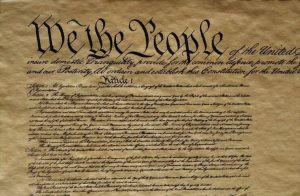 First page of U.S. Constitution.
First page of U.S. Constitution.
1787, U.S. Constitution finalized in Philadelphia, Sept. 17. There is strong debate over slavery, with many challenging it as immoral and abhorrent, including several leading Southerners. But South insists its economy is totally dependent. So, slavery is not forbidden; that’s left to each state to decide (outside Northwest Territories where it was forbidden earlier in the year).
_________________
The words “slave” and “slavery” do not appear in new Constitution, reflecting vocal discomfort with enshrining it into a founding document. But three articles touch on the young nation’s enslaved, who now number nearly 700,000:
Article I, Section 2 allots Representatives in the House and direct taxes according to the states’ respective populations, which are to be calculated “by adding to the whole Number of free persons [including indentured persons], and excluding Indians not taxed, three-fifths of all other Persons.”
“All other Persons” are the slaves. The Southern states want them counted in full, as they make up a major proportion of their populations, to maximize Southern representatives in the House. The Northern states argue they should not be counted at all, because their status is that of property not citizens. The Great Compromise is to count each slave as three-fifths of a person for this purpose only. The debate has no impact, either way, on slaves’ rights or wellbeing.
Article I, Section 9 prohibits laws that would ban “the Migration or Importation of such Persons as any of the States now existing shall think proper to admit” before 1808. This is an extremely obfuscated reference to the slave trade; the 21-year ban is a compromise between pro- and anti-slavery delegates. And in 1807, a law banning the slave trade to the U.S. from other countries—but not banning slavery itself or domestic slave trading—is passed, taking effect Jan. 1, 1808.
Article IV, Section 2 covers extradition by any state of persons charged with crimes who are found in another state. This is extended to runaway slaves with this language: “No Person held to Service or Labour in one State... escaping into another... shall be discharged from such Service or Labour, but shall be delivered up on Claim of the Party to whom such Service or Labour may be due.”
1787, Society for the Abolition of the Slave Trade forms in Britain. Nine of the 12 founders are Quakers, including five who signed the 1783 petition to Parliament. Three Anglicans join them, including Thomas Clarkson and Granville Sharp, a lawyer who took slaves’ side in the Somerset and Zong cases.
William Wilberforce of Yorkshire agrees to lead Parliamentary drive to ban slave trade at dinner with leading abolitionists, May, and is encouraged by his friend, William Pitt the Younger, prime minister since 1783. This is two years after Wilberforce’s self-searching evangelical conversion.
1787, Thomas Clarkson undertakes research and speaks in English cities against slave trade. In Liverpool, he is badly beaten by a gang of sailors said to have been paid to assassinate him. He survives and plays a leading role over the next 20 years.
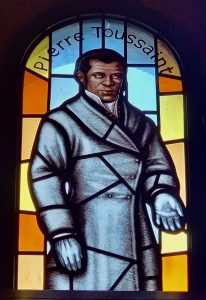 Pierre Toussaint.
Pierre Toussaint.
1787, As tensions mount in Saint-Domingue, the Bérard family leaves their plantation for New York, taking with them a 21-year-old slave, Pierre. He becomes successful hairdresser, supports the widow Bérard and is ultimately freed by her. In 1811, he takes the name Toussaint after Haiti’s revolutionary hero. Known as a benefactor of Catholic Church and schools for black children in New York, he is declared “venerable” by Pope John Paul II in 1996.
1788, U.S. Constitution ratified by New Hampshire (9th state to do so) making it the law of the land, June 21. Washington (Virginia) elected first president, November. John Adams elected vice president; Jefferson named secretary of state; Alexander Hamilton, secretary of the treasury.
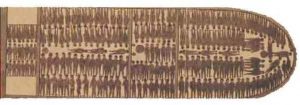 Slaves crammed together on ship.
Slaves crammed together on ship.
1788, British Parliament passes, by a significant majority, Slave Trade Act put forth by Sir William Dolben, which regulates number of slaves that a ship can carry to 1.67 slaves per ton up to 207 tons burthen. Also requires a doctor aboard and record keeping. Wilberforce among opponents, fearing it will undermine drive for complete abolition of the trade.
Example: One slave ship, Brookes, previously carried as many as 609 slaves, but now is limited to 454.
Mortality on British slave ships subsequently declines.
1788, In northern Senegal, coffles of captives being marched to the French factory at Île Saint-Louis, are stopped by followers of Abdel Kader Kane, the Muslim leader of Futa Toro. Ninety are freed.
The following March, Kane warns the governor at Saint-Louis to cease buying and enslaving Muslims captured by enemies of the Futa Toro. “All those who will come to our land to trade in slaves will be killed or massacred if you do not send our children back,” reads his letter.
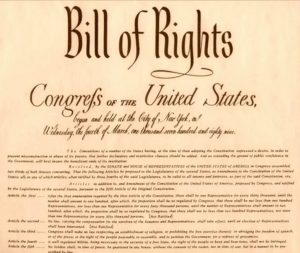 Bill of Rights.
Bill of Rights.
1789, First U.S. Congress, meeting in New York, adopts Bill of Rights, 12 amendments to the Constitution, Sept. 25.
Included are guarantees of freedom of religion, the right to free speech and trial by jury, protections against unreasonable search and self-incrimination, and more.
The 2nd Amendment is crafted by Madison to meet Virginia’s insistence that states will always be allowed to deploy militias of armed citizens. Virginia’s main fear? Slave rebellions.
Virginia is the 10th state to ratify 10 of the amendments, making them the law of the land, Dec. 15, 1791. The remaining two, addressing when Congress can increase its pay and future increases in membership of the House, fail to win 10 states.
Congress moves to Philadelphia in 1790 and, in 1800, moves again to Washington, DC. First session in the new Capitol building is held Nov. 17, 1800.
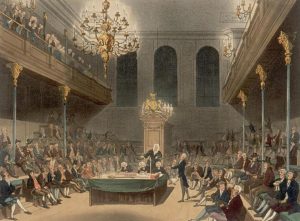 William Wilberforce gives speech against slave trade.
William Wilberforce gives speech against slave trade.
1789, Wilberforce gives his first speech against the slave trade in Parliament, May 12. But slave-trade proponents push issue into a committee for study.
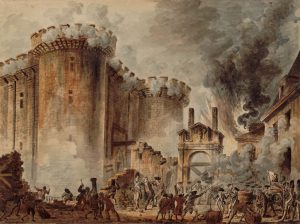 Soldiers Launch Attack on Bastille in Paris.
Soldiers Launch Attack on Bastille in Paris.
1789, Storming of Bastille in Paris ignites French Revolution, July 14.
National Assembly adopts Declaration of the Rights of Man, grounded in political ideas of the Enlightenment, Aug. 4. Drawn up by Lafayette who consults with Jefferson (in his last year as U.S. ambassador to France), and advanced by Honoré, Comte de Mirabeau.
Article I: “Men are born and remain free and equal in rights. Social distinctions can be founded only on the common good.”
But category of “passive citizens” continues the practice of withholding full political rights from women, children, slaves and foreigners.
Note: Jefferson begins relationship with teenage slave Sally Hemings (a half-sister of his late wife) in Paris. She negotiates special treatment for herself and freedom for any children to come. Four survive into adulthood and are freed, the last two only upon Jefferson’s death in 1826.
1789, Spanish crown (Charles IV, the new Bourbon king) issues El Código Negro for its Caribbean colonies to promote slave plantations, but also to allow slaves more opportunity to work their own plots of land and as craftsmen, with the right to buy freedom of their children and themselves. Over time, many are able to accomplish this.
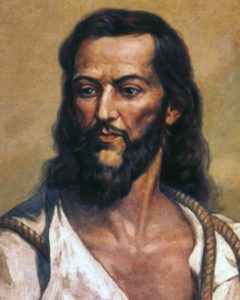 Joaquim Jose da Silva Xavier.
Joaquim Jose da Silva Xavier.
1789, Inspired by the American Revolution and angered by a royal tax on sagging gold production, a number of officers, intellectuals and priests in Brazil’s Minas Gerais captaincy plot to break free of Portugal. A smaller number also propose to abolish slavery.
But the plan is betrayed to the government. Most involved are exiled to Angola, but one leader, Joaquim José da Silva Xavier, is hanged in Rio de Janeiro, April 21, 1792. His butchered remains are ordered on display in Ouro Preto, the gold-rush capital. April 21 is now celebrated as a national holiday in honor of Da Silva. His nickname, Tiradentes (he was a dentist) has been taken by another town in Minas Gerais.
